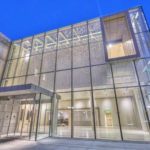Jason Sandford
Jason Sandford is a reporter, writer, blogger and photographer interested in all things Asheville.
 Asheville City Council voted 5-2 on Tuesday in favor of a major new River Arts District apartment complex that does not include any units defined as “affordable,” but will have a restaurant, artist studios and public parking.
Asheville City Council voted 5-2 on Tuesday in favor of a major new River Arts District apartment complex that does not include any units defined as “affordable,” but will have a restaurant, artist studios and public parking.
Vice Mayor Gwen Wisler and Councilman Gordon Smith voted against the Stoneyard Apartments proposal, with Mayor Esther Manheimer and council members Brian Haynes, Keith Young, Cecil Bothwell and Julie Mayfield voting in favor.
The sticking point for the 175 Lyman St. development (across the street from the old 12 Bones restaurant location) had been whether or not it would include units defined as affordable. (For an explanation of what’s defined as affordable, see this story.) Back in June, the Asheville Planning and Zoning Commission brought up the affordability issue as it considered the Stoneyard Apartment plans. The city is in the midst of an affordable housing crisis, some members noted, an issue the city is struggling with. The commission eventually voted 3-2 in favor of the project, with developer David LaFave declining to agree to set aside any lower priced units. He cited the high cost of building in a flood plain.
Tuesday night, several residents spoke to the affordability issue in urging City Council to vote down Stoneyard Apartments, which calls for the construction of four new buildings ranging from 32,000 to 44,700 square feet and 70 feet in height, as well as the reuse of one existing brick structure. The nearly 3-acre site is the former JR Stone Sales stone yard. A number of building owners and artists in the River Arts District spoke strongly in favor of the project.
Pro and con
A handful of residents expressed opposition to the project during the public comment period.
Casey Campfield reminded council members that Asheville was experiencing both “a period of unprecedented growth” and a housing crisis, and he said it was “disappointing to see zero units” designated for affordable housing. All the leverage rests on the side of city government, Campfield said, as he exhorted City Council to negotiate low rents “in perpetuity” for a set number of apartments.
Peter Landis said the developer’s concession to contribute $50,000 to the city’s Affordable Housing Trust Fund “seems fairly minuscule,” and he encouraged City Council to hold the developer more accountable on the affordability issue.
Kim Roney, a candidate for City Council who lost in last week’s elections, said artist studios included in the project were not affordable for her husband, an artist, and others in the community that she knew.
Several River Arts District artists and business owners, on the other hand, argued that Stoneyard Apartments would be good, on the whole, for the district and the city.
Pattiy Torno, the owner of CURVE Studios and an artist in the RAD for decades, told City Council that judging a project solely on the number of affordable apartment units it provided was too narrow a view of its public benefit. She praised developers their “tremendous outreach” to the community
Hedy Fischer, co-founder of Pink Dog Creative art studios, agreed with Torno that having residents in the RAD would boost artists and their businesses. She noted that there almost 1,000 affordable housing units nearby in the Glen Rock Apartments.
“Of course Asheville needs more affordable housing. We also need more housing in general and we also need more affordable artist studios,” Fischer said, something the Stoneyard Apartments project would provide.
Kari Rinn of the North Carolina Glass Center said she was a “firm believer that a high tide floats all boats” in urging City Council approval.
And Dave Campbell, president of the River Arts District Business Association, said his organization stood firmly in favor of the complex, calling it “one of the most exciting projects I’ve seen in the district” in the 18 years he’s been there. “It’s a neighborhood fit.”
Developer, City Council weigh in
LaFave, the developer, told City Council the project would meet city guidelines, fit the industrial character of the area and preserve the 110-year-old building known as the Carolina Coal and Ice building, a structure he said he’d fallen in love with. He said his team, which included Miles Alexander of Form & Function Architecture, and Michael Goforth of High County Engineering, had worked closely with the property owner, city staff and neighbors for five years. With that, he asked for approval.
In answer to a question about the cost of apartments and studio space, LaFave answered that he didn’t have final prices, but that in general, a studio apartment would cost in the $750 to $800 per month range, with a one-bedroom apartment going for the $1,100-a-month range. Two bedroom apartments would start in the $1,300 to $1,400-a-month range, he said.
The Carolina Coal and Ice Building would house 10 second-floor artist studios of 350 square feet each, LaFave said. They would not be “live-work” studios, but rather “work” only. Each would rent for between $300 to $400, he said, with larger studios renting for more. Each studio would have its own heating and cooling and rinse sink. The studios would be accessed via a lobby, and there would be public restrooms on the floor.
A restaurant is planned for the ground floor of the building LaFave added. The project received a variance to locate the restaurant in the flood plain, he said.
Council weighs in
Wisler, the vice mayor, said she approved of the adaptive reuse of the building, the public parking aspect (85 spaces for the public) and supported the major infrastructure project that’s transforming the River Arts District, “but not at the expense of our other values,” namely that of affordable housing. The issue has been identified as one of the city’s highest priorities, she said, and approving Stoneyard Apartments “flies in the face of our values.”
Wisler proposed that the developer agree to donate $175,000 to the city’s Affordable Housing Trust Fund instead of just $50,000. LaFave didn’t respond. Wisler also asked the developer to agree not to allow any apartments to be used as short term rentals. To that, LaFave expressly agreed.
Councilman Smith, one of City Council’s strongest advocates for affordable housing, said he appreciated his talks with the developers but agreed with Wisler. He noted that the city recently approved a boutique hotel in the River Arts District and was headed toward approving a big apartment complex with market rates.
“I wonder where we’re going with all this,” he said. He added that the project would earn his support if the developer agreed to Wisler’s proposed $175,000 contribution to the city trust fund.
Councilwoman Mayfield said she agreed with pretty much everything that everyone said. In the end, the 85 spaces of public parking moved her to support the development, she said. “We need this parking,” she said, noting that it costs $17,000 to build just one parking space.
“Do not think that I am stepping back from the need for private developers to commit to solving problems with the city,” Mayfield added, but with the project before her, “the parking is not a bad deal.” She said she was going to vote for Stoneyard Apartments.
Councilman Young echoed Young’s comments and reiterated his statement at previous meetings that development in the RAD would continue to be “a delicate balancing act.”
“One vote isn’t a blanket act of acquiescence,” Young said, and City Council will continue to consider projects as they come forward.
Councilman Bothwell cited his experience in the construction industry and said he was “acutely attune” to the high cost of building in a flood plain. With that high cost, he suggested that affordable housing units were better suited for other areas of the city, adding that the whole intent of the RAD infrastructure project was to attract the very type of development projects that Stoneyard Apartments represented.
While recognizing the need for affordable housing, Bothwell made the motion to approve the project. Councilman Haynes seconded the motion. The final vote tally was 5-2 in favor.


























This looks like project buildings in Brooklyn from a different era. So ugly!!
You need to correct your list of Yes votes in the second paragraph to include Keith Young.
Could be worse… The rents suck but at least they’ve forbidden STR’s in this project. If they were to ever ban those downtown, I wonder how many dozens of residential units would open up overnight for actual residents to live in.
Just one mention that this project in a flood plain. When that river puts on it’s big boy pants, they’re gonna learn a wet, soggy lesson. Next time you’re at that corner by the stone yard, where the original 12 Bones used to be, take a look east over at the building RiverLink is in. See that white paint mark on the corner of the building about 11 feet up? That was the high water mark, I believe in September 2004. This river goes out of it’s banks every year, sometimes several times a year. It’s supposed to. That whole valley is a flood plain.
That is why the first floor starts 16′ in the air and only parking is on the ground floor.
i would love to see proper punctuation and writing in so-called “Professional” journalism. apparently this doesn’t qualify as professional. Jason, you should know better.
“She noted that there almost 1,000 affordable housing units nearby”
That’s a typo, surely: there are precisely 60 units in the Glen Rock Depot.
Interesting to see long-standing artists like Torno, along with ones who set up shop in the RAD during the 2010 growth spurt like Fischer and Rinn, behaving not unlike Lou Bissette and Byron Greiner for downtown.
“Interesting to see long-standing artists like Torno, along with ones who set up shop in the RAD during the 2010 growth spurt like Fischer and Rinn, behaving not unlike Lou Bissette and Byron Greiner for downtown”
A long transition, I suppose. I can remember when Torno hosted a hardcore punk show on Monday nights on WCQS.
“Interesting to see long-standing artists like Torno, along with ones who set up shop in the RAD during the 2010 growth spurt like Fischer and Rinn, behaving not unlike Lou Bissette and Byron Greiner for downtown”
A long steady transition I guess. I can remember when Torno hosted a hard core punk show on Monday nights on WCQS.
And CURVE Studios was originally a straight-edge punk club back in the day.
I don’t begrudge artists being legacy stakeholders in the RAD, especially one like Torno who led the pack, got flooded out in ’04 and stuck around. On the other hand, if you treat them primarily as property owners, then you have to consider Chris Peterson’s complaints about eminent domain on the old 12 Bones site. And I don’t say that with any relish.
Let’s see what happens when studio owners receive offers from developers to sell up.
Yes, that will be the big test.